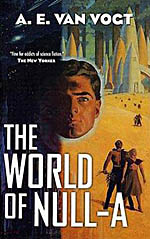
![]() couchtomoon
couchtomoon
9/17/2014
![]()
The anti-Sherlock style of non-Aristotelian logic, otherwise known as null-A, relies upon a psi-like quality of inductive reasoning—something my high school vocabulary development teacher would have dismissed as "fuzzy logic," and what I call, "jumping to conclusions based on a feeling." Being a smartass, it's something I rely upon quite often, though usually for humorous effect, seeing how ill-informed and hasty such inferences can be. Still, it's a funny pastime at work, when my colleagues and I are trying to figure out what the administrators are up to.
During the mid-20th century, however, supernatural-style inductive reasoning experienced a surge in interest, and influenced much of the SF world. Nearly every book I pick up from the fifties includes some sort of vague psychic element—not always the meat of the story, but usually as a world-building aside, indicating that many SF authors believed that humans of the future would undoubtedly have these psychic abilities. The null-A philosophy, promoted by Alfred Korzybski, influenced many SF authors, including Van Vogt, who built his Null-Aseries off of this idea.
But why am I talking about null-A, anyway? It's not like the book is really about this. Silly me.
The games are about to begin, and Gilbert Gosseyn wants to get far enough to win a trip to Venus, a trip both he and his recently deceased wife dreamed of taking. Like every games participant, Gosseyn goes to the Machine to be tested for his abilities, which he passes, but the Machine explains that Gosseyn's memories are planted and the Machine cannot figure out who he really is. Gosseyn's memories of his dead wife are false, and the woman he is mourning is alive, and happens to be the woman with whom he spent the previous night in an empty lot (she also happens to be the president's daughter, but he didn't recognize her). From there, Gosseyn is inserted into the mysterious politics of an ensuing war with Venus, and he is subsequently kidnapped, shot and killed, sent to Venus, blackmailed, sent back to Earth, accused of murder... he goes back to Venus—wait, he died again—or, the other people who were murdered are alive again, and there's a roboplane with the bellboy who is really an insurgent... but that guy disappears... trees on Venus have giant root systems that you can walk inside of... Oh! Gosseyn has an extra brain that is sort of like tapped into the Machine, but the Machine is blown up, and there are supposed to be three incarnations of Gosseyn, which is somehow linked to the genocide on Venus...
You need to practice null-A in order to follow the plot of this story.
Although not a single thread is followed through to the end of the novel, Van Vogt unleashes wild and bucking plotlines every few pages, fascinating the reader into distracted submission, just to see where the hell this thing is going. He starts with "the games," but that hardly comes up again, and we never learn whether they're Planet of the Damned-style or Hunger Games-style. "May the games prove you worthy of Venus" is a familiar-sounding refrain, even though it doesn't really matter. Characters who seem important vanish from the story after one act. Other characters keep returning, even when thought dead. (I'm pretty sure they were shot in the face– but the narrative swerved again, and I was too distracted to go back and confirm.) Van Vogt's Venus is pretty cool, with colossal trees and tunneled root systems, but don't get too comfortable—Gosseyn won't be there for long.
And let's not allow the suspense of uncertainty get in the way of another crazy plotline! Lie detectors, always located in the adjoining room, quickly resolve the characters' distrust of one another. If a shady malcontent makes a promise to our hero, Gosseyn pops into the next room, plugs in the lie detector, and the machine confirms the veracity of the promise. This happens in nearly every act. Even tree-encumbered Venus has lie detectors in convenient locations. (Based on most of the SF novels I've read from this age, people of the mid-20th really wanted lie detectors and expected them to become a reliable reality. I find it interesting how we've departed from that desire. Bullshit is so customary, we don't even desire a scientifically-dependable machine that monitors it anymore.)
The ludicrous plot swerves aren't quite enough to distract the reader from the tedious movement dumps and bizarre metaphorical language. At one point, Gosseyn spends three days living in an empty house on Venus where Van Vogt describes each one of his meals. One of Gosseyn's many captors, a man in a body harness and wheelchair, is described as looking like a "plastic nightmare beetle" (loc. 1350). In another scene, the captors dump Gosseyn's sandwiches on the floor, "with a vague sound, like pieces of dry dough" (loc. 1091). These were moments when I was reminded of that "Bad Metaphors by High School Students" post that's been tweeted around. They made me laugh out loud (for literals) and not for good reasons.
But in the end, The World of Null-A isn't as terrible as it sounds, especially for readers just looking for a crazy vintage ride. The ending qualifies for one of those mind-bendy Twilight Zoneconclusions, which may have been the impetus for this entire madcap journey. (Spoiler alert: it was him the whole time! Whatever that means!) Van Vogt also shoehorns in a few diatribes against genocide and propaganda, reminding the reader of the war-torn current events of the era. Still, The World of Null-A is a clunky tale that most readers won't care for.
I think.
I don't actually have the factual evidence to support that, but I just have this feeling...
Null-A!
http://couchtomoon.wordpress.com